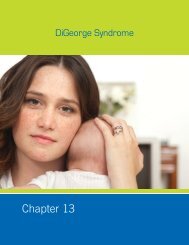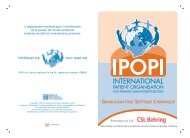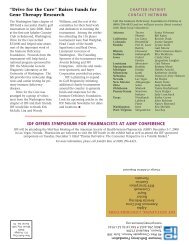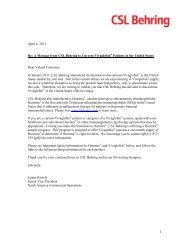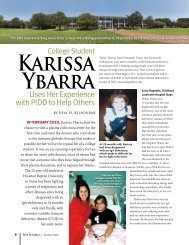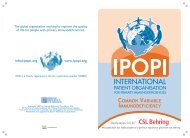IDF Patient & Family Handbook for Primary Immunodeficiency ... - IDFA
IDF Patient & Family Handbook for Primary Immunodeficiency ... - IDFA
IDF Patient & Family Handbook for Primary Immunodeficiency ... - IDFA
Create successful ePaper yourself
Turn your PDF publications into a flip-book with our unique Google optimized e-Paper software.
Wiskott-Aldrich Syndrome 41<br />
Treatment of Wiskott-Aldrich Syndrome continued<br />
The only “permanent cure” <strong>for</strong> WAS is bone<br />
marrow transplantation or cord blood stem cell<br />
transplantation (see chapter titled Specific Medical<br />
Therapy) and the search <strong>for</strong> an HLA-matched<br />
donor should be undertaken as soon as the<br />
diagnosis of WAS has been established.<br />
Because patients with WAS have some<br />
residual T-lymphocyte function in spite of their<br />
immunodeficiency, immunosuppressive drugs<br />
and/or total body irradiation are required to<br />
“condition” the patient be<strong>for</strong>e transplantation.<br />
If the affected boy has healthy siblings with<br />
the same parents, the entire family should be<br />
tissue typed to determine whether there is an<br />
HLA-identical sibling (a good tissue match) who<br />
could serve as bone marrow transplant donor.<br />
The results with HLA-identical sibling donor bone<br />
marrow transplantation in WAS are excellent with<br />
an overall success (cure) rate of 80-90%. This<br />
procedure is the treatment of choice <strong>for</strong> boys<br />
with significant clinical findings of the WAS. The<br />
decision to per<strong>for</strong>m an HLA-matched sibling<br />
bone marrow transplant in patients with milder<br />
clinical <strong>for</strong>ms, such as isolated thrombocytopenia,<br />
is more difficult and should be discussed with<br />
an experienced immunologist. Success with<br />
matched-unrelated donor (MUD) transplants has<br />
improved substantially over the past two decades.<br />
Fully matched-unrelated donor transplants are<br />
now almost as successful as matched sibling<br />
transplants if they are per<strong>for</strong>med while the patient<br />
is under 5-6 years of age and be<strong>for</strong>e they have<br />
acquired a significant complication such as<br />
severe viral infections or cancer. The success<br />
rate of fully matched-unrelated donor transplants<br />
decreases with age making the decision to<br />
transplant teenagers or adults with WAS difficult.<br />
Cord blood stem cells, fully or partially matched,<br />
have successfully been used <strong>for</strong> immune<br />
reconstitution and the correction of platelet<br />
abnormalities in a few WAS patients and may be<br />
considered if a matched sibling or fully matched<br />
unrelated donor is not available. In contrast to the<br />
excellent outcome of HLA-matched transplants,<br />
haploidentical bone marrow transplantation (the<br />
use of a parent as a donor) has been much less<br />
successful than are HLA-matched transplants.<br />
Expectations <strong>for</strong> Wiskott-Aldrich<br />
Syndrome <strong>Patient</strong>s<br />
Three decades ago, the classic Wiskott-Aldrich<br />
syndrome was one of the most severe primary<br />
immunodeficiency disorders with a life<br />
expectancy of only 2-3 years. Although it remains<br />
a serious disease in which life-threatening<br />
complications may occur, many affected males<br />
go through puberty and enter adulthood, live<br />
productive lives and have families of their own.<br />
The oldest bone marrow transplanted patients<br />
are now in their twenties and thirties and seem<br />
to be cured, without developing malignancies or<br />
autoimmune diseases.







